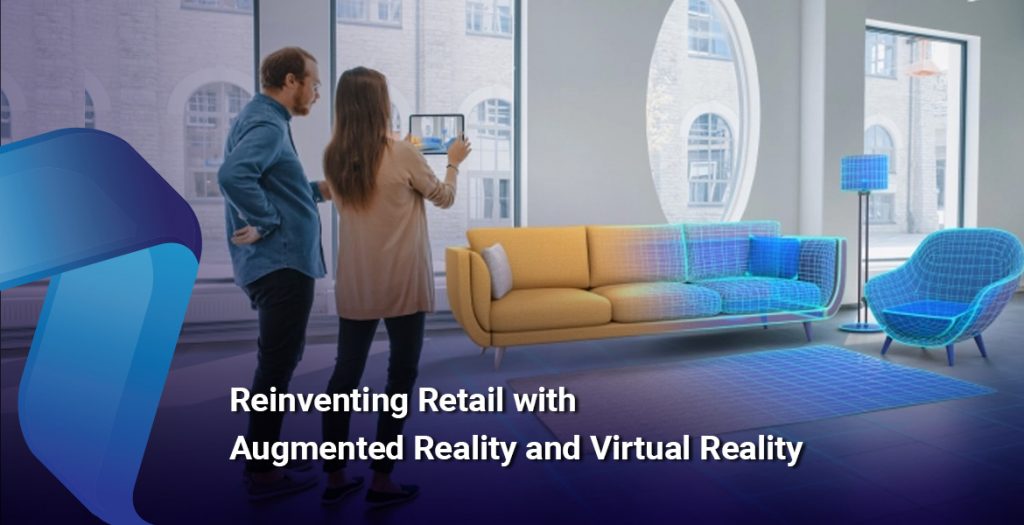The integration of immersive technologies has become the new gold standard for omnichannel retail and brand experiences.
By 2025, the global market for Augmented Reality (AR) and Virtual Reality (VR) will be worth USD 1.6 billion.1
Considering such a large potential market, retail enterprises must plan to create fully immersive, perpetual real environments for their consumers. The demand for these technologies to produce sophisticated consumer experiences has skyrocketed, allowing businesses to thrive and improve their financial prospects. Bringing AR and VR into retail is beneficial for both retailers and customers. It improves customer engagement and enhances the purchase experience while lowering operational costs for stores.
Augmented Reality in Retail
Retailers are experimenting with augmented reality in a variety of ways. This technology refers to the overlaying of digital entities over the surrounding reality, which can be accomplished via various devices such as a tablet or a smartphone.
Case Examples – Try Before You Buy
Isn’t it fantastic that you can try a product while checking it on a digital gadget before deciding to make a purchase? It is the most intriguing and engaging augmented reality in retail, that allows customers to try things on before purchasing them. Many e-commerce enterprises have adopted this on a large scale to increase customer engagement and sales.
Here are a few examples.
- Lenskart offers try-on feature that allow users to try on glasses by developing a 3D face model of the user’s face and photo-realistically digitizing the spectacles.
- Gucci’s mobile app allows customers to try on any pair of footwear virtually.
- Ikea’s app virtually positions furniture in the homes of customers.
Understand Products Better: By using AR technology, brands deliver additional information about their products. For instance, Toyota uses an augmented reality app to show buyers how their new hybrid vehicle works. With visuals of internal mechanics and processes included in the app, users better understand how their vehicle works.
Ease of Navigation: With augmented reality, customers easily navigate through large brick-and-mortar stores. When you enter a store with a list of items you wish to buy, the software recognizes the items on the shelf and determines the best path for you that includes all of them. Customers conveniently navigate merchandise and avoid getting lost in other areas without spending several hours in the store.
Find My Way is a mobile app that assists customers in finding their way in stores. Interestingly, it can also help you locate seats for a planned movie or event. It aims to keep minimum interaction with people and keep track of social isolation among those affected by the COVID-19 epidemic.
Virtual Reality in Retail
An ABI Research suggests that Virtual Reality in the retail and marketing industries will generate USD 1.8 billion by 2022.2
Virtual Reality can be a game-changer in the retail industry. It can be used to build, plan, and improve the consumer experience.
Case Examples
Explore Virtual Stores: Retailers can consider developing a virtual store to provide a better virtual shopping experience. Customers may rotate 360 degrees to examine every shelf visually. These engaging experiences entice customers to return and maintain loyalty.
Well-designed Stores: Using Virtual Reality’s capabilities, merchants can create a digital model of a store they intend to open. They can assess several designs, make modifications, and arrange them in the best possible way by producing this digital copy. They can also set things on shelves. It’s a simple approach to experiment with changing store goods in a virtual model before doing so in real life. Retailers can save time and money by adopting Virtual Reality.
Effective Planning: Virtual Reality can support store planning and product design. Retailers can leverage VR technology to create a product simulation to provide their customers with a more advanced degree of experience. While Audi enables clients to have a Virtual Reality driving experience with the help of a VR headset, Ford uses Virtual Reality to observe a virtual model of an automobile before manufacturing a real one.
Harness the power of AR-VR technology in your retail business. Continue studying what your users want to see and do with AR & VR. For the time being, it is safe to assume that AR and VR mobile applications are essential assets for the retail sector’s survival and expansion. We at MOURI Tech have proven tech specialists with the knowledge, experience, and resources to create tailored AR-VR solutions for your company.
References:













